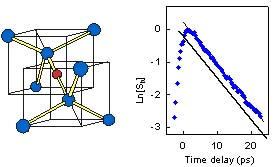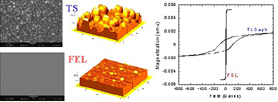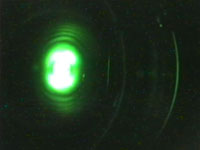IR Demo Highlights

Bond-center H in Si and its dynamical decay as measured at the JLab IR Demo FEL.
Linear Dynamics Results
Highlights of IR Demo linear dynamics results: hydrogen defects in silicon, and amide-1 vibrational energy relaxation in myoglobin. While elastic x-ray scattering yields important structural information, the function of materials can only be measured via experiments which probe the dynamical interplay between the electrons and phonons with high precision in both energy and time. Experiments at the JLab IR Demo FEL yielded critical information about the poorly understood ways in which hydrogen defects fundamentally limit the use of silicon. In these two-photon experiments, the FEL pump pulse was tuned to the frequency of the defect, and the subsequent energy relaxation processes were studied by a second photon at a matched frequency. Seven substitutional, interstitial, and vacancy defects were measured as a function of temperature for both hydrogen and deuterium. Surprisingly, relaxation rates varied by orders of magnitude even for defects close to each other in energy. Similar techniques were applied in a study of the "engine-of-life" protein myoglobin, the macromolecule that takes oxygen from hemoglobin via energetic pathways that are not understood and that are the basis of part of the metabolism process. Once again the dynamical processes were found to differ drastically even for closely spaced Amide-I vibrational modes.

Three comparisons of thin NiFe films as grown with an amplified Ti-sapphire laser (TS) and with the JLab IR Demo FEL. (Left: scanning electron microscope. Center: atomic force microscope. Right: hysteresis curves.)
Nonlinear Dynamics Results
Highlights of IR Demo nonlinear dynamics results: single-walled carbon nanotubes, and pulsed laser deposition of magnetic thin films. Intense peak electric fields (up to 1013 V/m), combined with the 75 MHz repetition rate, allowed experiments in an entirely new regime. Highlights have been the production of carbon nanotubes via the excitation of graphite in the presence of a catalyst and the creation of unique magnetic thin films. High yields of exotic carbon molecules were attributed to excitations within the excited plume that itself came from multiphoton absorptions. More work is needed to characterize and hence understand these nonlinear interactions in subpicosecond time scales. The magnetic thin films were produced by excitations of bulk material with subsequent deposition. The multiphoton absorption process led to the creation of hot material without the electronic excitation typically observed with tabletop lasers. Hysteresis curves were identical to the native material.


